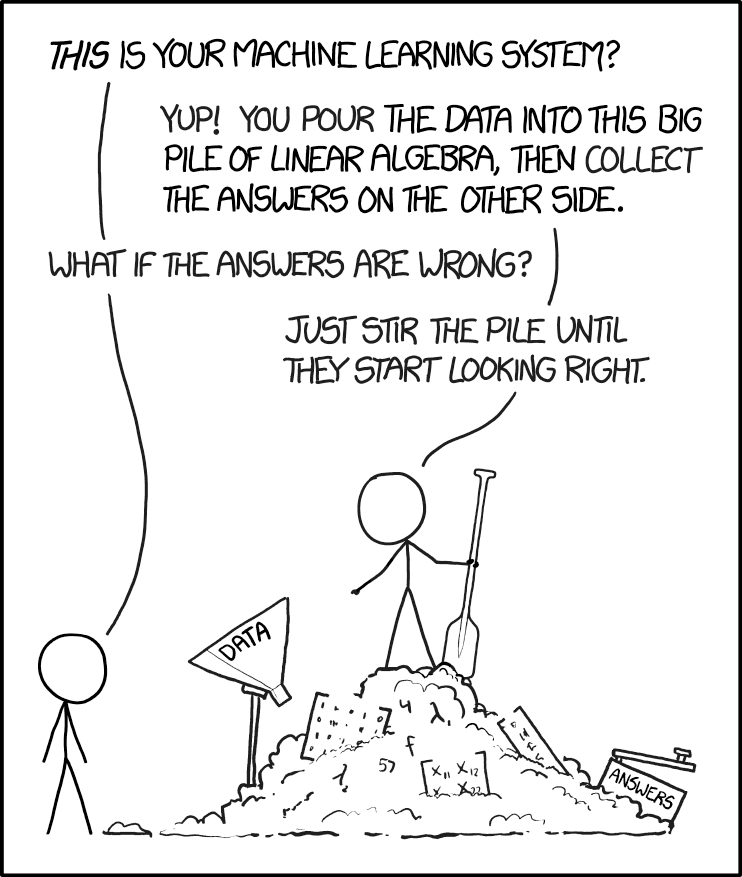using Pkg
Pkg.activate(pwd())
Pkg.instantiate()
using GraphPlot, Graphs, ImageCore, ImageIO, ImageMagick, ImageShow,
LinearAlgebra, MatrixDepot, MLDatasets, QuartzImageIO,
RDatasets, StatsModels, TextAnalysis
Introduction¶
Subject of linear algebra¶
Vector $\mathbf{x} \in \mathbb{R}^{n}$: $$ \mathbf{x} = \begin{pmatrix} x_1 \\ x_2 \\ \vdots \\ x_n \end{pmatrix}. $$
Matrix $\mathbf{X} = (x_{ij}) \in \mathbb{R}^{m \times n}$: $$ \mathbf{X} = \begin{pmatrix} x_{11} & \cdots & x_{1n} \\ \vdots & \ddots & \vdots \\ x_{m1} & \cdots & x_{mn} \end{pmatrix}. $$
Examples of vectors and matrices¶
Design matrix¶
In statistics, tabular data is often summarized by a predictor matrix or covariate matrix or design matrix or feature matrix, which is denoted by $\mathbf{X}$ by convention. Each row of the feature matrix is an observation, and each column is a covariate/measurement/feature.
The famous Fisher's Iris data:
# the famous Fisher's Iris data
# <https://en.wikipedia.org/wiki/Iris_flower_data_set>
iris = dataset("datasets", "iris")
We can turn a tabular data set into a feature matrix according to a model formula:
# use full dummy coding (one-hot coding) for categorical variable Species
iris_X = ModelMatrix(ModelFrame(
@formula(1 ~ 1 + SepalLength + SepalWidth + PetalLength + PetalWidth + Species),
iris,
contrasts = Dict(:Species => StatsModels.FullDummyCoding()))).m
# first training sample: image, digit label
# MNIST.traindata(1)
MNIST(split=:train)[1]
# first training digit
X = MNIST(split=:train)[1][1]
# apparently it's digit 5
convert2image(MNIST, X)
# 2nd training image in CIFAR10
X = CIFAR10(split=:train)[2].features
# is this a truck?
convert2image(CIFAR10, X)
Text data¶
Text data (webpage, blog, twitter) can be transformed to numeric matrices for statistical analysis as well. For example, the 29 State of the Union Addresses by U.S. presidents, from George W Bush in 1989 to Donald Trump in 2017, can be represented by a $29 \times 9610$ document term matrix, where each row stands for one speech and each column is a word that ever appears in these speeches. An entry $x_{ij}$ of the matrix counts the number of occurrences of word $j$ in speech $i$.
sotupath = joinpath(dirname(pathof(TextAnalysis)), "..", "test/data/sotu")
Base.Filesystem.readdir(sotupath)
crps = DirectoryCorpus(sotupath)
# Donald Trump 2017 SOTU address
text(crps[29])
standardize!(crps, StringDocument)
remove_case!(crps)
prepare!(crps, strip_punctuation)
update_lexicon!(crps)
update_inverse_index!(crps)
m = DocumentTermMatrix(crps)
D = dtm(m, :dense)
m.terms
Networks¶
The world wide web (WWW) with $n$ webpages can be described by a connectivity matrix or adjacency matrix $\mathbf{A} \in \{0,1\}^{n \times n}$ with entry \begin{eqnarray*} a_{ij} = \begin{cases} 1 & \text{if page $i$ links to page $j$} \\ 0 & \text{otherwise} \end{cases}. \end{eqnarray*} According to Internet Live Stats, $n \approx 1.98$ billion now. The smaller SNP/web-Google data set contains a web of 916,428 pages.
mdinfo("SNAP/web-Google") |> show
md = mdopen("SNAP/web-Google")
md.A
Here is a visulization of the SNAP/web-Google network

Such a directed graph can also be represented by an indicence matrix $\mathbf{B} \in \{-1,0,1\}^{m \times n}$ where $m$ is the number of verticies and $n$ is the number of edges. The entries of an incidence matrix are \begin{eqnarray*} b_{ij} = \begin{cases} -1 & \text{if edge $j$ starts at vertex $i$} \\ 1 & \text{if edge $j$ ends at vertex $i$} \\ 0 & \text{otherwise} \end{cases}. \end{eqnarray*}
Here is a directed graph with 4 nodes and 5 edges.
# a simple directed graph on GS p16
g = SimpleDiGraph(4)
add_edge!(g, 1, 2)
add_edge!(g, 1, 3)
add_edge!(g, 2, 3)
add_edge!(g, 2, 4)
add_edge!(g, 4, 3)
gplot(g, nodelabel=["x1", "x2", "x3", "x4"], edgelabel=["b1", "b2", "b3", "b4", "b5"])
# adjacency matrix A
convert(Matrix{Int64}, adjacency_matrix(g))
# incidence matrix B
convert(Matrix{Int64}, incidence_matrix(g))
